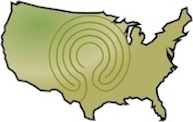
Where are we now and next?
Find out where the labyrinth is.

View videos
on our
YouTube channel.
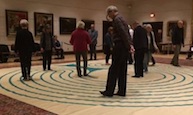
Join a walk.
What to expect when you
come to the labyrinth.

Tune in.
Listen to a recent podcast
interview about the project.
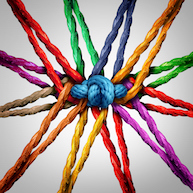
Get involved.
Find out about the different
ways you can get involved
with the project.
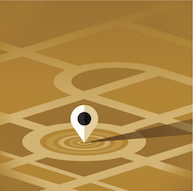
After your walk.
Exploring the labyrinth further –
for individuals and groups.
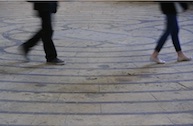
The great labyrinth at
Chartres in France
dates from the 13th Century.
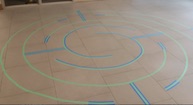
Labyrinths can be
easily marked out
in various ways.

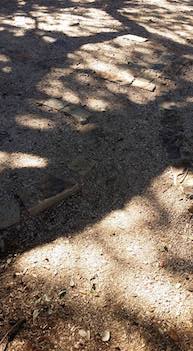
Outdoor labyrinths can
be found in
many locations.

Keep in touch.
Find out about our progress via our
Facebook page or blog.
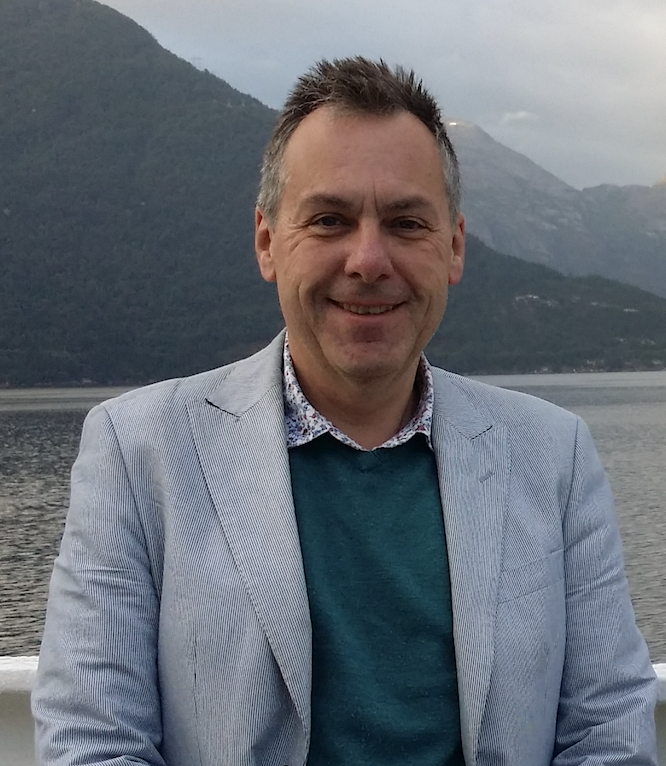
Clive Johnson.
Originator of
Labyrinth Around America.
Listen to Clive read a
sample from his new book,
'Labyrinth A–Ω'.
ABOUT THE PROJECT.
Here, the originator of the project, Clive Johnson, writes about his inspiration for launching the project, and explains what he hopes that it will achieve.
THE INTENTION / WHAT THE PROJECT IS ABOUT
My intention is to take a single portable labyrinth around the states that mark the boundaries of the United States (those that have a coastline, or which have a border with either Canada or Mexico). The notion is to ‘create a positive energy’ by the movement of the labyrinth in a circle around this great country, embracing both those who dwell within and along the path that the labyrinth takes, and those who come to walk, be with, or circle around the labyrinth as it makes its journey.
The project is birthed at a time of change and uncertainty in the USA (as well as in many other parts of the world). As at any time, any project that can help lift spirits, provide direction, and offer some means for healing divisions and building stronger community ties must be a welcome one.
The labyrinth offers one means for helping to sow seeds for refocusing and bringing people from different backgrounds together. It needs no words to be spoken or compromises to be met; it comes with no political bias, and makes no expectations of anyone who chooses to walk it. It does not ask for any monetary contribution to give its access, requesting only a small amount of each walker’s time. The labyrinth simply invites each individual to take a step forward, offering a common heart for everyone who treads its path.
I don’t begin with any notion that this project will be a solution to everyone’s or every community’s problems, or of itself bring about massive healing on a national basis. However, I am sure that it will make some difference – perhaps much more significant than I can foresee, and reaching beyond the stories that directly relate to this one labyrinth’s journey. I hope that the venture may ignite the imagination of communities, and help bring calm and fresh purpose for individuals. All who come to the labyrinth arrive from different places; all who walk it cannot fail to be touched by it. This is its mystery – and its gift.
I have no idea where the labyrinth will end its journey, if it will end it anywhere! Some, but not all, of my stops along my journey will be planned; others (e.g. whether I will be the one to take the labyrinth on its entire journey, and also to Alaska, Hawaii, and possibly other destinations beyond those containing the US mainland) will deliberately not be. I intend to make most, if not all, of my journey overland, but occasional air hops may be involved. In the places I visit, I hope to offer guidance and reference points for individuals who want to explore the labyrinth further (e.g. by pointing to the wonderful resources offered by The Labyrinth Society and others, and highlighting other initiatives, such as project empathy, which aim to help encourage a sense of understanding or uniting with ‘other’).
I aim to blog about the journey’s progress, and hope to encourage others to share their experiences from walking or coming into contact with the labyrinth along the way. I plan to make media organizations aware of the labyrinth’s course, and to bring awareness of the joy and gift of labyrinth walking among many who may never have encountered it before. I would like to see the labyrinth setting up a temporary camp in prisons, hospices, desolate neighbourhoods, community halls, churches, mosques, temples, public parks – who knows, if permission is given – even on the lawns of the National Mall!
My stay in each state will be brief, often allowing for only one or two ‘camps’ to lay the labyrinth at; there may be occasional breaks or deviations from the path; for example, to include festivals. Some such detours may be planned; others will almost certainly not be.
What happens to the labyrinth after its travelling around its initial circle is complete remains to be revealed, as does who may join me in helping it continue on its journey. This may include a continuing ‘baton passing’ from place-to-place, especially journeying to inland states, and places where there’s an urgent need for healing. Such a journey will require funding, as well as people other than myself to help carry the vision forward. I have a ‘go-fund-me’ page to help raise contributions toward the cost of the labyrinth itself, any venue hire costs, and to seed the funding for its ongoing journey, but not for my own costs. Contributions to a collecting box may also be invited at stopping points for the labyrinth, but not be required or over-emphasised. I’m sure that others will become involved in helping to manage and take decisions on how any funds raised might be used, and that what form the constitution for this (e.g. in the form of a Trust) should become apparent during the course of the labyrinth’s journey. What will happen is to be discovered – the labyrinth will show the way!
HOW THE IDEA WAS BORN
I have been captivated by the labyrinth for several years. My first contact came through a festival event in my old home city (Brighton & Hove, UK), through which I discovered opportunities for regularly walking a canvas labyrinth that was laid out each week in a local church. I’ve subsequently had a chance to walk various labyrinths, as well as having been introduced to many inspiring stories of how labyrinths have transformed communities and touched lives.
My inspiration for this project came especially from two women that I met at the 2016 gathering of The Labyrinth Society – one of whom has worked extensively with a ‘world peace’ labyrinth (a design created for the 2002 Winter Olympics in Salt Lake City), and the other who made her own odyssey around France with a portable labyrinth modelled on the famous installation at Chartres Cathedral.
Writing as I am now, at the outset of the initiative, the idea seems something like a pipe-dream – it doesn't obviously offer me a chance to make money at a time when a logically-oriented person might say that I ‘should’ focus my energy on an income earning venture. It is somewhat counter to my usual focus to take on something that has no fixed timescale or end goal. It will cost me money that I'm not good at saving.
However, the idea hasn’t gone away since it first came to me, and my attempts to look for guidance on whether this is a venture that I should pursue have all pointed to an affirmative reply. This included a strong indication that I should follow my path when I walked the beautiful labyrinth inside Grace Cathedral, San Francisco last November. Further, positive leadings have come to me since, and – perhaps most importantly – I feel very drawn to making this journey, and to making it around the USA, rather than my own country or continent. The fact that I’m both a friendly outsider to US communities, and something of a nomad who enjoys road journeys, might play a role in this attraction!
WHAT IS MY MOTIVATION FOR THE PROJECT?
I see my role as essentially being one of initiating, holding and ultimately passing on the care for the labyrinth’s journey; connecting with people along the way who can help with local hosting, facilitation, and other aspects of the project; and welcoming, hosting, and offering follow-on suggestions for individuals who come to walk the labyrinth – especially those who are new to it.
I hope that others may capture the same vision that I have, and possibly feel moved to participate in some way. I do not feel a strict sense of ownership over the course that the project will take – indeed, it’s my hope that the labyrinth will ultimately ‘find its way’, and become a resource that’s not owned or claimed by any one group or person.
Early opportunities to participate may include holding, praying for and encouraging the journey (not just the labyrinth’s and mine, but everyone who walks it and comes into contact with it). Folks who may be able to suggest or help give access to venues for hosting walks will play important parts, while a few may even feel motivated to facilitate walks and/or travel with me for a stage or two of the journey!
I am not motivated by any political, religious or ideological agenda or purpose, other than a desire that the labyrinth should be fully inclusive of all people who walk it. I strongly hope that people from many different backgrounds, perspectives, ethnicities, faith traditions (including those of none) will come to walk this labyrinth – that it becomes a welcome host for the great diversity of humanity of which we are all a part.
WHAT QUALIFIES ME TO UNDERTAKE THIS PROJECT?
I can’t easily answer this question. Passion, having a vision, and feeling ‘led’ are the most important drivers for me. I have trained and been certified as a labyrinth facilitator by Veriditas (the principle training body), and am also an interfaith minister. However, I believe that the most vital traits for a host of a venture such as this are a will to offer my time and my commitment for it, to be open to my own learning and receiving what the labyrinth has to offer me, and a readiness to be ‘on the road’ for quite a few weeks at a time (in practice, there are likely to be a number of breaks along the way, as I need to fulfil commitments elsewhere that I’ve already made).
WHY THE LABYRINTH FOR HEALING AND COMMUNITY BUILDING?
Many have described the benefits to communities and in personal and organizational healing that has come about through various labyrinth initiatives. Labyrinths are found in many different settings, and there is much documentary evidence pointing to their often powerful, positive effects. They are a non-partisan, universal symbol of unity, and seem to imbue the communities and places where they are sited with a new energy and sense for the wellbeing of others.
A portable, canvas labyrinth that was made to support the work of Rev. Dr. Lauren Artress of Grace Cathedral, San Francisco, is largely responsible for bringing awareness of the labyrinth to modern communities, spawning a mass interest in labyrinth creation and walking in thousands of communities around the world. A simple resource that can be carried from place-to-place offers a powerful opportunity for one or just a few individuals to bring about a movement of change on a large scale, in a way that few other initiatives can do. What’s more, labyrinth walking is available to anyone, not requiring any more than a simple introduction. No qualification or prior experience is needed to enjoy immediate benefit from walking a labyrinth.
WHY THE CHOICE FOR A BALTIC DESIGN?
I’ve taken time to try to discern which labyrinth design is ‘right’ for this initiative. A ‘Baltic-type’ design (so called since there are many labyrinths of this form found along the coasts of Scandinavia) has stood out as having a strong attraction from the beginning.
This might appear to be a curious choice, since there are very popular alternative patterns found in classical, medieval, and other labyrinth types, together with several modern designs (for example, the World Peace Labyrinth, South African Reconciliation Labyrinth) that might seem especially well suited for a project that aims to bring together people who hold different perspectives, and where they may be a strong need for bringing about healing and creating harmony among a group of people.
I’ve not felt that a multi-entry design is right for this project – a pattern that encourages people to come from different starting points (as they may be coming from in terms of their different world views). Rather, I see that we all start from different places as we come toward the labyrinth, even if we all ultimately come together along our paths. So too, we don’t necessarily know what the points of difference are with a neighbour that we might follow into, or pass by, during a labyrinth walk; neither need we. Every step on the labyrinth is unique. Every walk is different. But everyone meets at the same center.
What is important is taking a decision to step onto a path that has been marked with the energies of many others (and through its timeless symbolism, connects us with our ancestors and transcends cultures). Those who come to walking do so with a will to be open. Our walks take us away from the disagreements, frustrations, and anxieties of the everyday. All of us are approaching our center, a center that’s shared by us all. All will receive something from walking, and turn to face out of the labyrinth with a fresh perspective or having been changed in some way, however small, and whether or not this may be immediately apparent to us.
Walking a Baltic-type labyrinth has been likened to entering the embrace of the womb, what some see as the safety and comfort of ‘the goddess’ or Mother Earth. This design is also thought to have been used in earlier times by fisherfolk seeking protection and blessing before they set out on their often dangerous voyages.
The Baltic design allows for a ‘processional’ path to be followed – its path to the center is different from its (much shorter) path out. This means that the only paths of others that might need to be passed are those of a walker approaching from behind another, but moving at a different pace; there is no opportunity for any ‘face-to-face’ encounters along the path, no potential for crossed paths or confrontations.
The short path out from this pattern suggests to me a movement that’s coming back into a united community (hopefully at least, this may be an intention that might be felt by many at the center) – a call to putting into action what’s been received, and to promptly bringing about change in both our own lives, and in the way we relate to others. What’s learned in the labyrinth may need to become integrated and consolidated, but this need not involve contemplating a long process before making an impact in the here and now.
However, the truth is, I don't know what has drawn me to this particular design – and it’s probably right that I don’t fully understand why either. The reasons why the labyrinth has endured as a powerful archetypal symbol in many cultures through history aren’t known, and perhaps it is right that its secrets remain as such. Quite possibly, what touches us when we walk a labyrinth happens at a deep level that we may not even be conscious of – our task is just to trust in its power to change and to heal, simply ‘to be’.
The project is kindly supported by The Labyrinth Society with a grant and as one of its special projects.
About Me (Clive Johnson)
I am an interfaith minister (trained by the One Spirit Interfaith Foundation in London) and a writer, an Englishman in my 50s, who spends much of my time on the road. I also house-sit, run occasional workshops and retreats, and am a nomad by nature. My professional background was in management consultancy and project management, but I am now focused on projects that allow me to follow my heart. I am UK based, but have no fixed home.
Questions about spirituality, personal development, and mythology occupy a lot of my thinking and writing. For example, these are themes explored in my recent books – Picturing God, Fairy Stories & Fairy Stories, Arabian Nights & Arabian Nights, Understanding Interfaith, and Being Spiritual, and in my forthcoming books, A Prayer for America and Archetypes.
My new book, Labyrinth A–Ω, explores the lure of labyrinths, giving a brief history of the labyrinth, suggesting how to approach the labyrinth, and ways in which you might investigate labyrinth walking further (including making or acquiring your own).
I have no other purpose for commencing this journey other than it feels right. I have no definite plan about where it might end.
